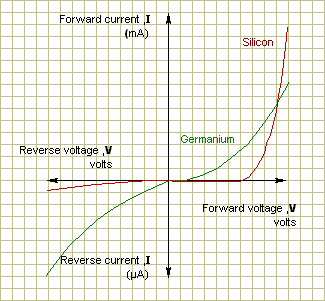
|
Electronic circuits and components
Fundamentals
Passive Components
Semiconductors Passive Circuits
Active Circuits
Parts Gallery |
Diodes /
Diode Characteristics<^< Forward and Reverse Bias | Course Index | Worksheet: Diode Characteristics >^>  Graph showing diode characteristics An 'ideal' diode would conduct perfectly in the forward direction and act as a perfect insulator in the reverse direction. Real diodes (made from silicon or germanium) are somewhat less perfect as they exhibit ohmic resistance in both the forward and reverse directions. In addition, the forward threshold voltage for a silicon diode is approximately 0.65V whilst that for a germanium diode is approximately 0.2V. The reverse breakdown voltage is usually very much higher than the forward threshold voltage - for example, a typical general-purpose diode might have a forward threshold voltage of 0.65V and a reverse breakdown voltage of 200V. If this latter voltage is exceeded, the diode may suffer irreversible damage. The characteristics for silicon diodes make them ideally suited for use as rectifiers and switches whilst lower voltage germanium types are better suited to small signal applications. <^< Forward and Reverse Bias | Course index | Worksheet: Diode Characteristics >^> |